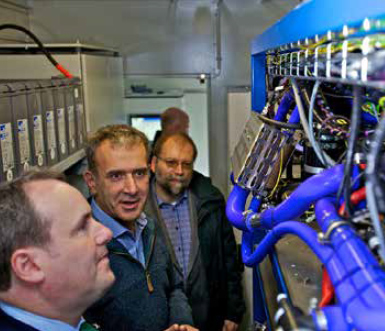The future of energy in Scotland: Scottish energy strategy
Scotland's first energy strategy sets out the Scottish Government’s vision for the future energy system in Scotland.
Ministerial Foreword

Choices affecting our energy future are among the most important we face. Scotland's social and economic well-being, and the sustainable productivity and competitiveness of our economy, depend upon a secure, affordable and reliable energy supply. Our energy sector also provides high quality jobs, and a vibrant climate and opportunity for innovation.
The decisions and actions which we take now will shape the Scotland that future generations will live and work in, visit and enjoy. Our vision, set out in this document, strengthens our international reputation for sustainability – we are an ambitious country of outstanding natural beauty, determined to build on our reputation as a renewable energy powerhouse.
This is our Energy Strategy for the period through to 2050 – the result of the lengthy consultation and series of discussions which we embarked upon almost a year ago. It maps out a major transition over the next three decades – a transition which is fully consistent with our climate ambitions, and with Scotland's Climate Change Act. It embodies and reflects our objective to create a dynamic, sustainable and inclusive economy.
Energy represents an enormous economic and industrial opportunity for Scotland. Our oil and gas industry and heritage will remain the bedrock of our future energy system – supplying energy, but also expertise and skills to support our transition to a different, low carbon energy future.
Low carbon and renewable energy already supports thousands of jobs across Scotland, generating billions of pounds in turnover. Scottish yards and workers are already fabricating and manufacturing some of the components that will power our energy future; our supply chains are growing, and the opportunities for innovation are immense. In the future, demand for low carbon skills, goods and services will grow both here in Scotland, and overseas, offering ever greater export opportunities.
Delivering the goals and policies in this Strategy can build on what's been achieved to date – creating more jobs, more investment, and a stronger, more sustainable Scottish economy.
Scotland's electricity production has changed enormously since the turn of the century, sparked by the huge and welcome increase in new renewable generation. We are well on the road to fully decarbonising our electricity system in Scotland. The challenge facing us now is to ensure a similar decarbonisation of our energy requirements for sustainable transport – and to deliver a well-balanced system capable of providing secure and affordable energy to meet Scotland's needs.
Scotland is taking a leading role in promoting electric and other low-emission vehicles – with an ambition to phase out the need for new petrol and diesel cars and vans by 2032. This is as much an energy system ambition as a transport one. We will need to develop and manage the necessary charging and other network infrastructure, while building awareness and confidence on the part of consumers. The challenges here are more than matched by the economic opportunity and environmental benefits which success will bring.
We have much more choice now over how we produce and consume the energy we need. Solar panels or small wind turbines can now help meet energy demand at a household or community level. Groups of consumers may choose to invest jointly in new local energy solutions in the future such as renewable electricity or heat networks, using gas and electricity networks only as backup to local supplies.
Developments in storage technology, and its application at a range of scales – from batteries (including the role of electric vehicles) at a household or local level, to the continuing value of Scotland's existing and new pumped storage hydro – will also have a major influence on our future energy system.
The pace and extent of these disruptions in the energy market create benefits for consumers, but there will be challenges too. This is where government, at all levels, can make a real difference – and the Scottish Government is determined to do so. We will make sure that the benefits are universal, and that change works for everyone across our society – preventing new forms of social exclusion amongst those less well equipped to take advantage of opportunities created by changing markets and smart technologies.
And we know too that energy remains unaffordable for far too many in Scotland, creating hardship for individuals and families. Energy prices and market failures play an obvious part in this – but we also have a building stock in parts of Scotland that is old and, all too often, profoundly wasteful in energy.
Our progress in this area is encouraging. However, continuing to improve the energy efficiency of Scotland's buildings – both domestic and non-domestic – and, over time, decarbonising the heat supply to those buildings, providing warmer homes and better outcomes for our consumers, remains a major challenge. It is a challenge that we are determined to meet.
We are grateful to all who have taken part in the process which has led to this Strategy's publication. It is not the end of the story; it is a live document – a route map, which sets out the first steps on a journey. A number of external factors and developments will influence our progress; however, as Abraham Lincoln once said – "the best way to predict the future is to create it."
We look forward to continuing to work with you all.
Paul Wheelhouse
MSP
Minister for Business, Innovation and Energy
Paul Wheelhouse MSP at the ‘Surf n Turf’
hydrogen fuel cell training compound, Kirkwall, Orkney. (Credit:
Colin Keldie)

Contact
There is a problem
Thanks for your feedback